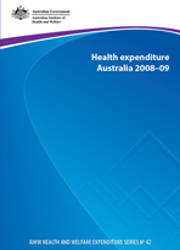Summary
Expenditure on health in Australia has increased from $10.8 billion in 1981–82 to $112.8 billion in 2008–09. At the same time, Australia’s gross domestic product (GDP) increased from $172.3 billion to $1,132 billion, so health expenditure as a proportion of GDP has gone from 6.3% in 1981–82 to 9.0% of GDP in 2008–09. The $112.8 billion spent on health goods and services during 2008–09 averaged out at $5,190 per Australian.
This report looks at the period from 1998–99 to 2008–09 and includes important information about the costs of health care in Australia, in terms of both the total number of dollars spent and the proportion of Australia’s national income that is spent on health. It also looks at the types of health goods and services that attracted funding and where that funding came from. The report also examines Australia’s health spending from an international perspective—how it compares with the region and with other developed economies.
Shares of expenditure
Of the total spent in 2008–09, 94.9% ($107.1 billion) was recurrent expenditure on health goods and services. The remaining 5.1% was capital expenditure ($5.7 billion).
Spending on public hospital services in 2008–09 was estimated at $33.7 billion or 31.5% of total recurrent health expenditure. Expenditure on medical services at $19.8 billion, or 18.5% of recurrent expenditure, and medications, at $15.2 billion (14.2%), were other major contributors to total recurrent health spending.
Growth in expenditure
Total health expenditure grew by $9.2 billion between 2007–08 and 2008–09, representing growth of 8.8% in nominal terms or 5.8% in real terms (Table A8).
Increased spending on public hospital services of $1.6 billion in real terms was the largest component of the overall increase in spending in 2008–09, accounting for over one-quarter (25.6%) of the increase in that year, followed by spending on medications which grew by 1.3 billion.
Total recurrent funding for medications increased by 9.6% between 2007–08 and 2008–09, well above the average growth of the previous 6 years of 6.9% (2003–04 to 2008–09). This increase has been strongly influenced by a 9.7% growth in expenditure on benefit–paid pharmaceuticals between 2007–08 and 2008–09.
The area of expenditure with the highest percentage growth was health research, which grew by 29.7% in real terms, although this is likely to partly reflect the impact of a changed survey methodology used by the Australian Bureau of Statistics. Patient transport services (largely made up of ambulance services) had the second highest percentage growth in 2008–09—up 15.4%.
Between 1998–99 and 2008–09, Australia’s expenditure on health in real terms (after adjustment for inflation), grew at an average of 5.4% per year, compared with average growth in real GDP of 3.2% per year.
Percentage of GDP
It is important to note that the GDP figure for 2008–09 includes an increased scope of production activities due to Australia adopting a new international standard, the System of National Accounts 2008. As a result, percentages of health expenditure to GDP reported in previous reports in this series are now out of date.
In 2007–08, health expenditure totalled $103.6 billion and its proportion of GDP has been revised to 8.8%.
Government share of expenditure
Governments funded 69.7% of total health expenditure during 2008–09, up from 68.7% in 2007-08 and up from 67.0% of expenditure in 1998–99.
The Australian Government’s share of public hospital funding was 44.3% in 1998–99 and this decreased to 38.6% in 2006–07. The share of public hospital funding provided by the Australian Government has since increased to 39.6% in 2008–09. State and territory governments’ share of public hospital expenditure was 51.2% in 2008–09, down from 52.8% in 2007–08 but up from 48.4% in 1998–99.
Expenditure in each state and territory
In terms of health expenditure occurring in each state and territory (that is, expenditure funded by all sources, not just that by the state or territory governments in question), over half (57%) of the $107.1 billion in national recurrent health expenditure in 2008–09 was spent in the two most populous states, New South Wales ($34.6 billion) and Victoria ($26 billion).
The average annual growth in recurrent health expenditure between 2003–04 and 2008–09 ranged between 4.4% in New South Wales and 7.5% in the Northern Territory. In comparison, the national average growth in recurrent health expenditure was 5.4% in the same period.
International comparisons
According to the Organisation for Economic Co-operation and Development (OECD) definitions, Australia’s health expenditure as a proportion of GDP was 8.7%, which was 0.4 percentage points lower than the median in 2008 for member states of the OECD. United States health expenditure as a proportion of GDP in 2008 was 16.0%. The change to the calculation of GDP adopted by Australia has also impacted on international comparisons reducing Australia’s health to GDP ratio, particularly in comparison with other countries that have not yet adopted the new standard.
Government funding of health expenditure as a proportion of total health expenditure was 66.8% for Australia in 2008 as compared to the median for OECD countries of 74.8%.



